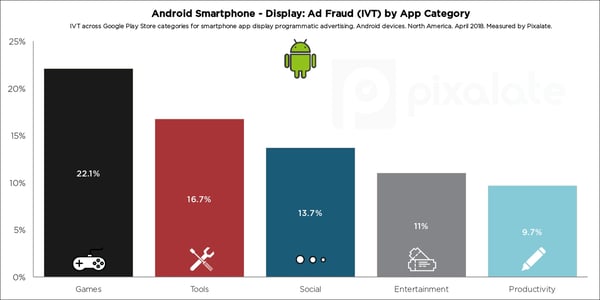
This week's review of ad fraud and quality in the digital advertising space.

Pixalate data reveals that Android devices were hit hard by mobile in-app ad fraud in Q2 2018. The ‘Games’ category has a display IVT rate of 22% on Android smartphones, while the ‘Tools’ category has a video IVT rate of 35%. Read the blog, or download the full Q2 2018 Programmatic Quality Report to learn more.

In a Q&A with Street Fight Magazine, Pixalate's Amy King, VP of product marketing, "talks about the implications of the high rate of fraud in programmatic ad traffic and what publishers should be doing but often aren’t to lower the bad numbers." You can read the full Q&A here.

eMarketer writes that "ad fraud still plagues digital media's supply chain," pointing to a recent study conducted by Guardian U.S. which found that there "was clear evidence that unauthorized players were pretending to sell Guardian inventory and diverting the revenue to themselves." Another recent survey, from Ad Lightning, found that nearly 60% of U.S. ad operators believe tracking down bad actors in the supply chain is the leading challenge in addressing ad quality issues.

The Drum spoke with four of its judges for The Drum Digital Trading Awards USA 2018 to get their thoughts on the most pressing issues in programmatic today. According to the judges, "standardization, viewability, ad fraud, and brand safety" are the biggest challenges in the industry.

According to Engadget, citing NiemanLab, "about a third of the 100 largest US newspapers have blocked European visitors to their sites rather than complying with the new" General Data Protection Regulation (GDPR). "Months after GDPR privacy rules went into effect, over a thousand US news sites still aren't available in Europe," wrote Engadget. "That includes outlets like WGN, the Los Angeles Times and Chicago Tribune and publishers including Tronc, Lee Enterprises and GateHouse Media."
Sign up for our blog to stay updated with new stats, trends, and analysis of digital ad fraud.
*By entering your email address and clicking Subscribe, you are agreeing to our Terms of Use and Privacy Policy.
These Stories on Weekly Recaps
*By entering your email address and clicking Subscribe, you are agreeing to our Terms of Use and Privacy Policy.

Disclaimer: The content of this page reflects Pixalate’s opinions with respect to the factors that Pixalate believes can be useful to the digital media industry. Any proprietary data shared is grounded in Pixalate’s proprietary technology and analytics, which Pixalate is continuously evaluating and updating. Any references to outside sources should not be construed as endorsements. Pixalate’s opinions are just that - opinion, not facts or guarantees.
Per the MRC, “'Fraud' is not intended to represent fraud as defined in various laws, statutes and ordinances or as conventionally used in U.S. Court or other legal proceedings, but rather a custom definition strictly for advertising measurement purposes. Also per the MRC, “‘Invalid Traffic’ is defined generally as traffic that does not meet certain ad serving quality or completeness criteria, or otherwise does not represent legitimate ad traffic that should be included in measurement counts. Among the reasons why ad traffic may be deemed invalid is it is a result of non-human traffic (spiders, bots, etc.), or activity designed to produce fraudulent traffic.”

